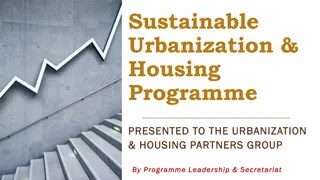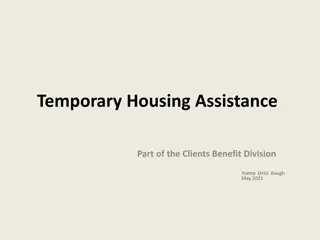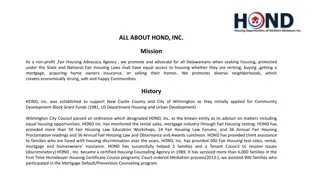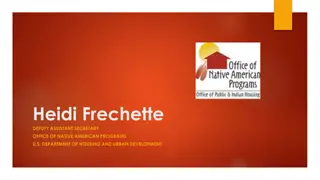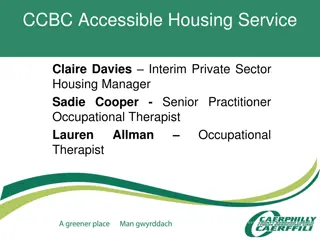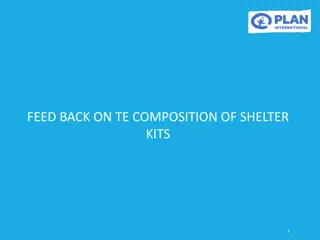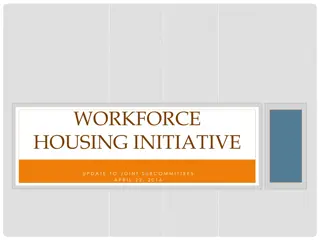Different Types of Housing and Shelter Options
Exploring the concept of shelter, this content delves into the various forms of housing available to meet human needs, considering factors like climate, design, and functionality. From traditional houses to modern complexes, it highlights the diversity of shelter options and their significance in providing protection and comfort to individuals.
Download Presentation

Please find below an Image/Link to download the presentation.
The content on the website is provided AS IS for your information and personal use only. It may not be sold, licensed, or shared on other websites without obtaining consent from the author.If you encounter any issues during the download, it is possible that the publisher has removed the file from their server.
You are allowed to download the files provided on this website for personal or commercial use, subject to the condition that they are used lawfully. All files are the property of their respective owners.
The content on the website is provided AS IS for your information and personal use only. It may not be sold, licensed, or shared on other websites without obtaining consent from the author.
E N D
Presentation Transcript
Chapter 22: Designing a Sustainable Home Shelter
What I Will Learn To explain the term shelter To differentiate between a house and a home To assess the different types of housing available To identify the factors that influence our housing choices
Shelter Shelter is a basic human need. From the earliest times, humans have made shelters to protect or shield themselves from the weather and other dangers. Types of shelter vary with climate and other conditions, e.g. in a colder climates a well- insulated house is needed for warmth and for protection from wind, rain and snow. In warmer climates, houses are needed for protection from intense heat and tropical storms.
Shelter Comes in Many Forms House Houses can be two, three or four storeys (floors) high or single-storey, e.g. A bungalow (a single-storey house) A dormer (a single-storey house with rooms in the roof space) Houses can also be: Detached (not attached to another house) Semi-detached (sharing a wall with one other house) Terraced (in a row of attached houses)
Shelter Comes in Many Forms (continued) A self-contained living area in a larger building, e.g. a converted house A small complex or a high-rise block that contains similar units Vary in size and design One room divided into living and sleeping areas for a single person A flat or apartment Bedsit
Shelter Comes in Many Forms (continued) Groups of specially designed houses or apartments where older people or those with disabilities can live on their own but with certain shared facilities There is usually a caretaker or supervisor living on site too Groups of people live in one building, e.g. student accommodation or a nursing home Sheltered housing Residential housing
Shelter Comes in Many Forms (continued) These include caravans, pre-built mobile homes, boats or tents They can provide permanent or temporary accommodation Mobile home
Housing Choice Our choice of housing is influenced by: Location: Where the house is located, i.e. rural (in the country) or urban (in a city); its proximity to work, schools, shops and amenities or to the surrounding community. Cost: People are restricted by the amount of money they can afford to spend. Size: The number and size of rooms should be suitable for the number of people in the family. Style: The design and layout of the house must appeal to the family, e.g. modern or traditional.
Housing Choice (continued) Special needs: Some accommodation can be adapted to meet the needs of the individual, e.g. wheelchair user. Availability: The availability of housing is also important as there may be a housing shortage in some areas, e.g. cities. Energy efficiency: An energy-efficient home has good insulation, uses sustainable materials and has an environmentally friendly energy and heating system.
Activity: Housing Think Pair Share Discuss the different types of housing and choose a housing option for each of the following people: a) A young professional couple who want to work and live in the city centre b) A student who is living away from home for the first time c) An older woman who wants to move from an isolated area into the nearest large town d) A young farmer, his wife and two children e) A family with school-going children f) An older man with arthritis who has difficulty with movement See Activity 22.3 in the TRB
What Makes a Community? A community is a group of people who live together in a local area. Each community has its own services and amenities (useful and desirable leisure features in a local area). Some community services are statutory (provided by the state) and some are voluntary (provided by volunteers). Statutory services: Schools, health centres, social services, libraries, Garda , post offices Voluntary services: Youth clubs, sport clubs, active age groups, mother and toddler groups, St Vincent de Paul, book clubs, and musical and drama groups
Amenities Amenities are desirable and useful features or places to spend leisure time in your local area, e.g. parks, walks, beaches, playgrounds, sports fields, cinemas, swimming pools and leisure centres.
Services and Amenities Activity Draw or download a map of your local area. Mark in all the amenities and services you can on this map. Don t forget to include statutory and voluntary services. Present your map to the class, and discuss who could use each service and amenity. See Activity 22.4 in the TRB
House or Home? A house becomes a home when it is occupied by people and their possessions. It becomes more than a shelter it provides for all our needs, making it a comfortable and safe place to live.
A Home Provides for: Physical needs: Food, warmth, shelter and clothes. Emotional needs: Love, security, protection and privacy. A home must protect more vulnerable family members, such as babies, young children and older people. Social needs: Learning to interact with others, communicate, share and co-operate A family s needs are constantly changing, so homes must adapt too.
QuickRevision 1. Define the term shelter . 2. Explain the difference between a house and a home. 3. Identify the different types of housing available. 4. Discuss the factors that influence our housing choices. 5. List five services or amenities a young family might want close by their home.



